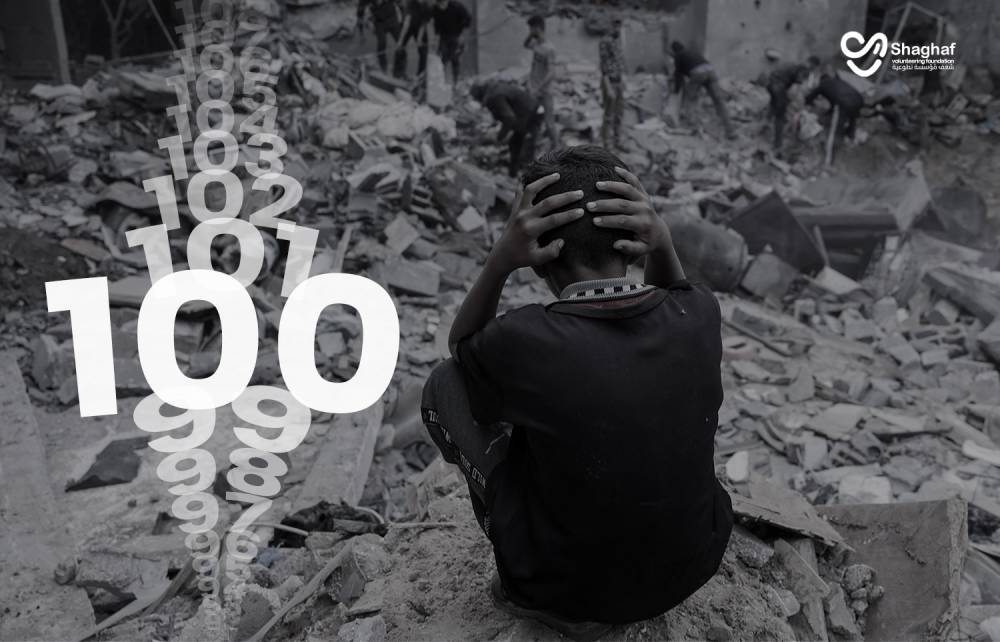
Since the 7th of October 2023, Israel has launched a full war on the Gaza Strip in retaliation to Hamas’ armed attack on the settlements of the strip on said date. This is the first time in 50 years that Israel has announced an official state of war and operated according to emergency law. This war, which the Israeli government initiated to eliminate Hamas and its infrastructure in Gaza, has surpassed 100 days, and the losses on the civilian side in the strip are much more than anticipated.
During the 100th day of the war, and based on research conducted by news outlets and humanitarian and legal institutions, Palestinian lives lost have surpassed the losses in all conflicts of this century, including Yemen, Ukraine, Afghanistan, and Iraq. According to UNRWA, these statistics are a harsh indication of the humanitarian catastrophe and the urgent need for instant humanitarian intervention. However, until this very moment, many institutions are prohibited from entering Gaza to provide help to the people. Furthermore, the Red Cross is banned from being present in areas of clashes to relieve remaining civilians.
This article sheds light on the pressing humanitarian crisis and the number of martyrs, injured, and missing civilians until now in the Gaza Strip.
Lives lost exceed the expected
According to the Palestinian Central Bureau of Statistics, the number of martyrs in the Gaza Strip has exceeded any other conflict during this century in proportion to the number of days of war. To date, an estimated 24,100 martyrs have died due to the Israeli assaults and ground operation inside the Gaza Strip, including 12,345 children, 7,100 women, 1,049 elderly people, 337 martyrs of medical personnel, 117 journalists, 209 martyrs of educational personnel, 148 martyrs of UNRWA employees, 45 Civil Defense martyrs, and 7,000 missing, 4,700 of whom are women and children.
The total number of wounded in the Gaza Strip reached 61,154, including 6,168 children. The number of displaced people in the Gaza Strip has exceeded the Nakba, with 2 million displaced people registered with the Ministry of Health and UNRWA, noting that they are clustered in the smallest provinces in the Gaza Strip in terms of area and population, which causes a stifling crisis, especially in light of the scarcity of food supplies, the insufficient entry of aid, the extremely high prices and the lack of control over sales and trade by the ruling authority.
The number of detainees from the Gaza Strip reached 3,000 prisoners during the Israeli army’s ground operation, and some other sources said that the number exceeds 5,000 prisoners.
The infrastructure in the Strip was destroyed by more than 75%, with 355,000 housing units entirely or partially damaged. The number of partially damaged housing units reached 290,000, and 69,300 housing units were completely destroyed, 30 hospitals are entirely out of service, more than 25,010 buildings are demolished, 25 hospitals are partially damaged, three churches were destroyed, and 145 mosques were destroyed. 138 government headquarters and 95 school and university buildings were utterly destroyed, 295 school and university buildings were partially damaged, and 121 ambulances were destroyed entirely.
After the war ends
With the ambiguity following the political state post-war and its ending, many questions are contemplated about how long the institutions and countries will take to revive and rebuild the strip. The Humanitarian Affairs office of the UN announced that the cost of providing humanitarian relief for 2.7 million people in the Gaza Strip is estimated to be 1.2 billion dollars, a cost much higher than the one estimated on October 12th, 2023, the previous being 294 million dollars.
Majdi al-Saleh, Minister of Local Government of Palestine, has estimated 8.4 billion dollars to be the cost of rebuilding the housing sector alone, adding that the destruction reached over 240,000 housing units, requiring either full or partial rebuilding. He asserted that removing the turmoil left behind costs 20-25 percent of the construction value, adding another 1.6 billion dollars to the bill.
The Minister also added that it would take six months minimum after the war ends to count the losses, adding that water, electricity, and sanitation sectors require 3 billion dollars to atone for the damage accumulated.
Humanitarian institutions’ role
Relief and humanitarian institutions have been banned from entering the Gaza Strip since the first day of the war. International institutions are prohibited from doing their job befittingly as the Israeli army abstains from coordinating with the Red Cross to enter areas of heavy clashes or to rescue civilians stuck under the rubble since the first day of the war.
We at Shaghaf Volunteering Foundation hope relief and humanitarian institutions, including us, will be allowed legal entry to provide aid for civilians as soon as possible. Every delay in institutions' entry and assistance in the strip will further aggravate the humanitarian situation.
Maisaa Mansour
Subscribe to our newsletter